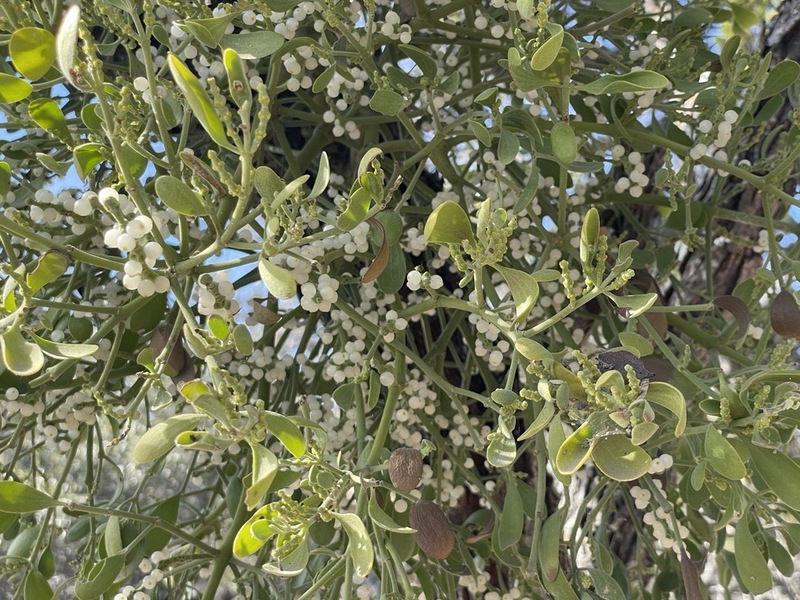Mistletoe is a popular Yuletide decoration. However, it is a parasitic plant that can be damaging to trees. It also has poisonous properties and should never be eaten.
American mistletoe, genus Phoradendron, is a persistent, evergreen, photosynthetic (contains chlorophyll), seed-producing plant. It is parasitic on certain woody plants, primarily hardwood or broadleaf trees.
Except for during Christmas holidays, mistletoe is probably not a particularly popular plant, especially if it is growing in a valuable shade or ornamental tree in your yard.
Impact
Generally speaking, mistletoe is not considered to be a serious pest of trees, so don’t kiss your tree good-bye if it is infected with mistletoe.
When heavy infection occurs, mistletoe becomes an additional stress factor to trees and may contribute to poor tree health. Though it’s unlikely to kill trees directly,tree branches may die because of mistletoe infection.
Because the leaves of the mistletoe plant contain chlorophyll (green color), the plant can produce its own food through photosynthesis using water and minerals derived from the tree that supports it. The leaves are leathery and occur opposite each other on the stem.
Mistletoe requires direct sunlight for best development, which is why it’s usually found high in the crown of tall trees. It may change from green to a greenish-yellow color during the winter months, but this is not an indication that the plant is unhealthy.
The best indication of mistletoe infection is seeing dense clusters of vegetation in the crown of host trees. The evergreen mistletoe plant is most easily recognized in the winter months when deciduous trees have dropped their leaves.
Trees vary in their susceptibility to mistletoe with water oak, sugarberry, and elm being the most commonly infected. Ash, beech, cherry, dogwood, sweet gum, hickory, maple, Osage-orange, persimmon, sassafras, walnut, sycamore, and willow also may be infected. It has been reported on 110 different species of trees in the eastern U.S.
Identification
In East Texas, mistletoe is dioecious. Meaning male and female flowers are borne on separate plants. The flowers are small and creamy-white in color. Only the female flowers produce seeds, which are white and embedded in a sticky, gelatinous pulp making the seeds to stick to the bark of trees.
The seeds are commonly distributed by sticking to the beaks and feet of birds or by bird droppings after passing through their digestive system. Under favorable temperature and moisture conditions, the seeds germinate almost anywhere, but trees will only become infected when seeds germinate on the thin bark of small branches.
Successful infection of a host tree happens when the mistletoe seed germinates and a root-like structure (haustoria) penetrates the bark through a lenticel or bud. It is common for the tree branch to be enlarged where the mistletoe plant attaches to the branch.

The aerial portion of the plant develops very slowly the first year, growing less than half an inch. Under ideal conditions, mistletoe may develop an aerial spread of three feet in six to eight years.
The longevity of mistletoe plants seems to be limited only to the life of the host tree with some plants living for more than 100 years. On average, the aerial portion of a single mistletoe plant survives less than eight years, being easily broken off by storms. Destruction of the aerial portion of the plant usually stimulates the development of dormant buds and multiplies the presence of the plant on its host.
Management
Mistletoe has few natural enemies, and effective control is very difficult. Where feasible, you can take steps to minimize mistletoe problems in trees.
Mistletoe plants mature in two to three years, so mechanically removing the aerial portion of the plant before it matures and produces seeds can benefit some. Small, infested limbs can be removed by pruning if they can be reached.
Mechanical removal of the aerial portion of the plant on large limbs may also be helpful. Removing part of the wood where the mistletoe attaches to its host should be avoided though because it usually causes more damage than the mistletoe itself. Keep in mind that mechanical removal must be done repeatedly because new sprouts will grow from the mistletoe imbedded in the wood of the host tree. Mechanical removal is suggested only if it can be done safely and economically.
In theory, covering the aerial portion of the plant, or its point of attachment after it has been removed, with black plastic (or other suitable material) would block sunlight and the plant would eventually die. However, in practice, applying black plastic high in the top of a tree can be difficult and dangerous.
Plastic also tends to deteriorate over time and would be unattractive, especially in the winter months when trees are bare.
Applying herbicide to mistletoe during winter when the host tree has no leaves has met with limited success. However, because it is so easy to damage the host tree and other nearby plants, using herbicide is not recommended.
A plant growth regulator called ethephon (FlorelÒ Fruit Eliminator) is the only product registered in the USA for the control of mistletoe on deciduous trees. Local nurseries or feed and seed stores may handle FlorelÒ.
So, what do you do with mistletoe? Enjoy it, because you probably won’t be able to successfully eliminate it from your tree.
